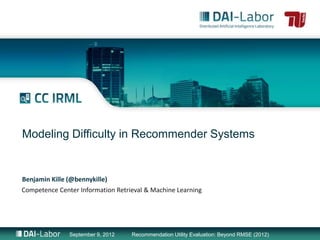
Modeling Difficulty in Recommender Systems
- 1. Modeling Difficulty in Recommender Systems Benjamin Kille (@bennykille) Competence Center Information Retrieval & Machine Learning September 9, 2012 Recommendation Utility Evaluation: Beyond RMSE (2012)
- 2. Outline ► Recommender System Evaluation ► Problem definition ► Difficulty in Recommender Systems ► Future work ► Conclusions September 9, 2012 Recommendation Utility Evaluation: Beyond RMSE (2012) 2
- 3. Recommender Systems Evaluation ► Definition of Evaluation measure: RMSE (rating prediction scenario) nDCG (ranking scenario) Precision@N (top-N scenario) ► Splitting data into training and test partition ► Reporting results as average over the full set of users ► Is recommending to all users equally difficult? September 9, 2012 Recommendation Utility Evaluation: Beyond RMSE (2012) 3
- 4. Observed Differences ► Users differ with respect to Demographics (e.g., age, gender and location) Taste Needs Expectations Consumption patterns … ► Recommendation algorithms do not perform equally for each single user users should not be evaluated all in the same way! September 9, 2012 Recommendation Utility Evaluation: Beyond RMSE (2012) 4
- 5. Risks of disregarding users‘ differences ► A subset of users receives worse recommendations than possible ► recommendation algorithm optimization targets all users equally: „easy“ users costs could be saved „difficult“ users insufficient optimization Control optimization towards those users who really require it! How to determine difficulty? September 9, 2012 Recommendation Utility Evaluation: Beyond RMSE (2012) 5
- 6. Problem Formulation ► Measuring how difficult it will be to recommend items to a user ► Ideally: deriving difficulty directly from user attributes ► Problem: unkown correlation between (combinations of) attributes and difficulty ► We need a method to calculate the correlation of user attributes and the recommendation difficulty September 9, 2012 Recommendation Utility Evaluation: Beyond RMSE (2012) 6
- 7. Difficulty in Information Retrieval ► Target object: query ► Method: Query IR-System IR-System IR-System IR-System IR-System Doc 1 Doc 1 Doc 1 Doc 2 Doc 1 Doc 2 Doc 2 Doc 3 Doc 1 Doc 2 Doc 3 Doc 3 Doc 2 Doc 4 Doc 4 … … … … … Difficulty = Diversity of returned list of documents September 9, 2012 Recommendation Utility Evaluation: Beyond RMSE (2012) 7
- 8. Difficulty in Recommender Systems ► Selecting several recommendation methods (state-of-the-art) ► Measure the diversity of their output for a specific user ► Based on the methods‘ agreement with respect to predicted rating / ranking / top-N items, we conclude: high agreement low difficulty low agreement high difficulty ► Target correlation (user attributes ~ difficulty) can be estimated using the observed difficulties for a sufficiently large set of users September 9, 2012 Recommendation Utility Evaluation: Beyond RMSE (2012) 8
- 9. Future Work ► Experimentally verify feasability of difficulty estimation ► Evaluate observed correlation (user attributes ~ difficulty) on data sets ► Investigate business rationale (reduced costs through controlled optimization efforts) ► How to deal with sparsity / cold-start issues September 9, 2012 Recommendation Utility Evaluation: Beyond RMSE (2012) 9
- 10. Conclusions ► Users should not be treated equally when evaluating recommender systems ► Difficulty of recommendation tasks varies between users ► Difficulty will allow to control optimization towards those users who require it ► Diversity metrics could be used to estimate difficulty scores (analogously to information retrieval) ► Proposed method needs to be evaluated September 9, 2012 Recommendation Utility Evaluation: Beyond RMSE (2012) 10
- 11. Thank you for your attention! Questions September 9, 2012 Recommendation Utility Evaluation: Beyond RMSE (2012) 11
- 12. References [He2008] J. He, M. Larson, and M. De Rijke. Using coherence-based measures to predict query difficulty. ECIR 2008 [Herlocker2004] J. Herlocker, J. Konstan, L. Terveen, and J. Riedl. Evaluating collaborative filtering recommender systems. ACM TOIS 22(1) 2004 [Kuncheva2003] L. Kuncheva and C. Whitaker. Measures of diversity in classifier ensembles and their relationship with the ensemble accuracy. Machine Learning 51 2003 [Vargas2011] S. Vargas and P. Castells. Rank and relevance in novelty and diversity metrics for recommender systems. RecSys 2011 September 9, 2012 Recommendation Utility Evaluation: Beyond RMSE (2012) 12